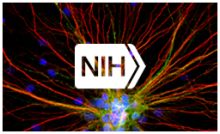
The BRAIN Initiative℠ goal is to develop neurotechnologies that will enable scientists “to map the circuits of the brain, measure the fluctuating patterns of electrical and chemical activity flowing within those circuits, and understand how their interplay creates our unique cognitive and behavioral capabilities.” On March 4, 2015 the NIH BRAIN Multi-Council Working Group (MCWG) met for the second time to discuss current BRAIN Initiative activities, new notices of funding opportunities, and strategic planning for the future of the NIH BRAIN Initiative efforts. The BRAIN MCWG includes one member of the Advisory Council from each of the 10 NIH Institutes and Centers that contribute to the NIH BRAIN Initiative. In addition, at-large members are appointed to supplement MCWG expertise, and ex officio members are appointed from the Defense Advanced Research Projects Agency (DARPA), the Food and Drug Administration (FDA), the Intelligence Advanced Research Projects Activity (IARPA), and the National Science Foundation (NSF) – NIH’s four federal partners involved in The BRAIN Initiative℠. The purpose of the MCWG is to provide oversight for the long-term scientific vision of The BRAIN Initiative℠ and serve as a forum for initial “concept clearance” or the review of ideas for new initiatives before they become funding announcements.
BRAIN: Then and Now
NIH released six funding opportunities in early 2014. This resulted in a robust response; 58 grants received funding. Currently, there are 13 active BRAIN funding opportunities that focus on next generation human imaging, recording modulation technologies, next generation human devices for recording and modulation, and short courses.
At the MCWG meeting (watch the videocast for more details), program staff presented exciting new Funding Opportunities for FY16 after reviewing on-going efforts in FY15. These new funding opportunities seek projects that investigate the foundations of human imaging; theories, models, and methods for analysis of brain data; technology sharing and propagation, to help disseminate technologies and techniques developed under the BRAIN initiative; and one on Research Opportunities using Invasive Neural Recording and Stimulating Technologies in the Human Brain. Meeting participants discussed the potential for public-private partnerships that offer collaborative opportunities for engaging sectors outside of the government, as well as upcoming workshops hosted by NIH on cell-typing in the brain and novel devices for intracranial recording and stimulation.
Ex officio MCWG members presented overviews of BRAIN-related activities at their agencies. Dr. Jim Olds described projects awarded by NSF to support potentially transformative insights into brain function, including a joint program for Collaborative Research in Computational Neuroscience. Dr. R. Jacob Vogelstein discussed several neuroscience programs being run by IARPA that use multidisciplinary approaches to advance understanding of cognition and computation in the brain. Dr. Justin Sanchez outlined several projects focused on movement and motor control, traumatic brain injury, and neuropsychiatric illness that are being funded by DARPA. Dr. Carlos Peña explained how the FDA is joining The BRAIN Initiative℠ to enhance the transparency of the regulatory landscape for neurological medical devices.
Looking Ahead
Thoughtful discussions with MCWG members highlighted opportunities for collaboration between BRAIN Initiative Federal agencies moving forward. For example, NIH and NSF may consider partnering to sponsor short courses for early stage investigators. Enhancing communication and coordination across participating BRAIN Initiative agencies will be critical going forward. Outreach across disciplines will be an important aspect of The BRAIN Initiative℠, and new partners from the fields of engineering and statistics, for example, should be engaged. Standardization between regulatory bodies, particularly the FDA and NIH Institutes and Centers, could increase the success of producing products that are applicable to the marketplace. Finally, the NIH will strive to maintain a balance in funding opportunities, where new ideas from investigators across a spectrum of career stages are encouraged, while still maintaining focus on the end-goals of the Initiative.
As The BRAIN Initiative℠ matures, we anticipate the development of funding opportunities for new research areas, and most importantly, the application of these technologies to solve fundamental questions about how our brains function. We would like to take this opportunity to say Thank You to all of the MCWG members, federal ex officio members, and staff who participated in this important meeting, and we look forward to working together in this effort to revolutionize our understanding of the human brain.
Sincerely,
Walter J. Koroshetz, M.D.
Acting Director, NINDS
Thomas R. Insel, M.D.
Director, NIMH
Co-chairs
BRAIN Multi-Council Working Group
Watch the webcast of the March 4 MCWG Meeting
Read more about the BRAIN MCWG
Learn about current NIH BRAIN Initiative funding opportunities
Learn about the unique efforts of NIH’s Federal partners in the BRAIN Initiative
Participating Institutes and Centers and NIH leadership for The BRAIN InitiativeSM:
National Center for Complementary and Integrative Health – Dr. Josephine Briggs, Director
National Eye Institute – Dr. Paul Sieving, Director
National Institute on Aging – Dr. Richard Hodes, Director
National Institute on Alcohol Abuse and Alcoholism – Dr. George Koob, Director
National Institute of Biomedical Imaging and Bioengineering – Dr. Roderic Pettigrew, Director
Eunice Kennedy Shriver National Institute of Child Health and Human Development – Dr. Alan Guttmacher, Director
National Institute on Drug Abuse – Dr. Nora Volkow, Director
National Institute on Deafness and Other Communication Disorders – Dr. James Battey, Director
National Institute of Neurological Disorders and Stroke – Dr. Walter Koroshetz, Acting Director
National Institute of Mental Health – Dr. Thomas Insel, Director
